Solar Energy: Photovoltaic Panels (PV)
VerifiedAdded on 2023/02/01
|12
|2921
|30
AI Summary
This article discusses solar energy production and storage, focusing on solar energy conversion, functioning, and the various types of Photovoltaic cells (PV). It also highlights the trends, benefits, and shortcomings of solar energy and the future of solar power production.
Contribute Materials
Your contribution can guide someone’s learning journey. Share your
documents today.

Running head: SOLAR ENERGY 1
Solar Energy: Photovoltaic Panels (PV)
Student
Institutional Affiliation
Solar Energy: Photovoltaic Panels (PV)
Student
Institutional Affiliation
Secure Best Marks with AI Grader
Need help grading? Try our AI Grader for instant feedback on your assignments.
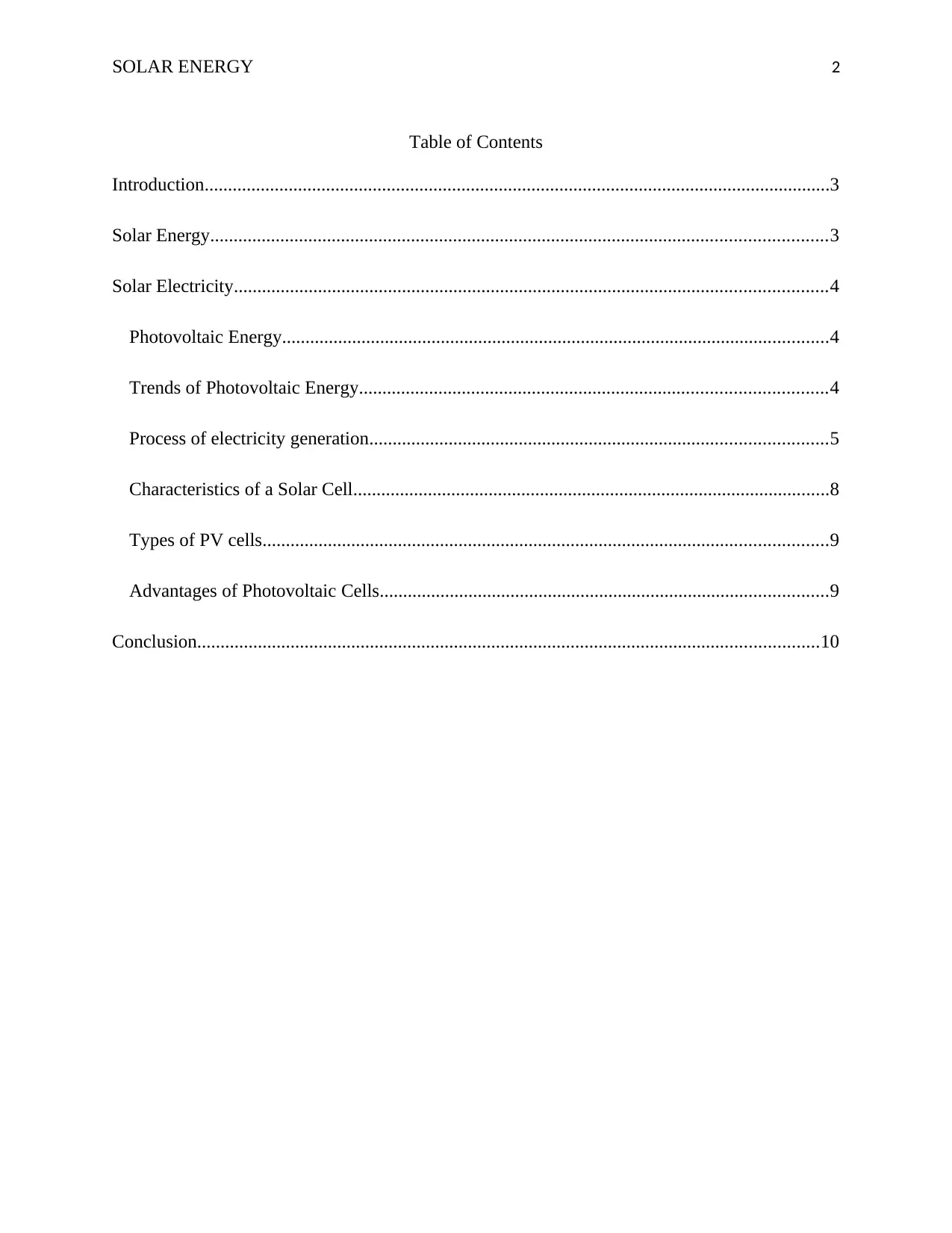
SOLAR ENERGY 2
Table of Contents
Introduction......................................................................................................................................3
Solar Energy....................................................................................................................................3
Solar Electricity...............................................................................................................................4
Photovoltaic Energy.....................................................................................................................4
Trends of Photovoltaic Energy....................................................................................................4
Process of electricity generation..................................................................................................5
Characteristics of a Solar Cell......................................................................................................8
Types of PV cells.........................................................................................................................9
Advantages of Photovoltaic Cells................................................................................................9
Conclusion.....................................................................................................................................10
Table of Contents
Introduction......................................................................................................................................3
Solar Energy....................................................................................................................................3
Solar Electricity...............................................................................................................................4
Photovoltaic Energy.....................................................................................................................4
Trends of Photovoltaic Energy....................................................................................................4
Process of electricity generation..................................................................................................5
Characteristics of a Solar Cell......................................................................................................8
Types of PV cells.........................................................................................................................9
Advantages of Photovoltaic Cells................................................................................................9
Conclusion.....................................................................................................................................10
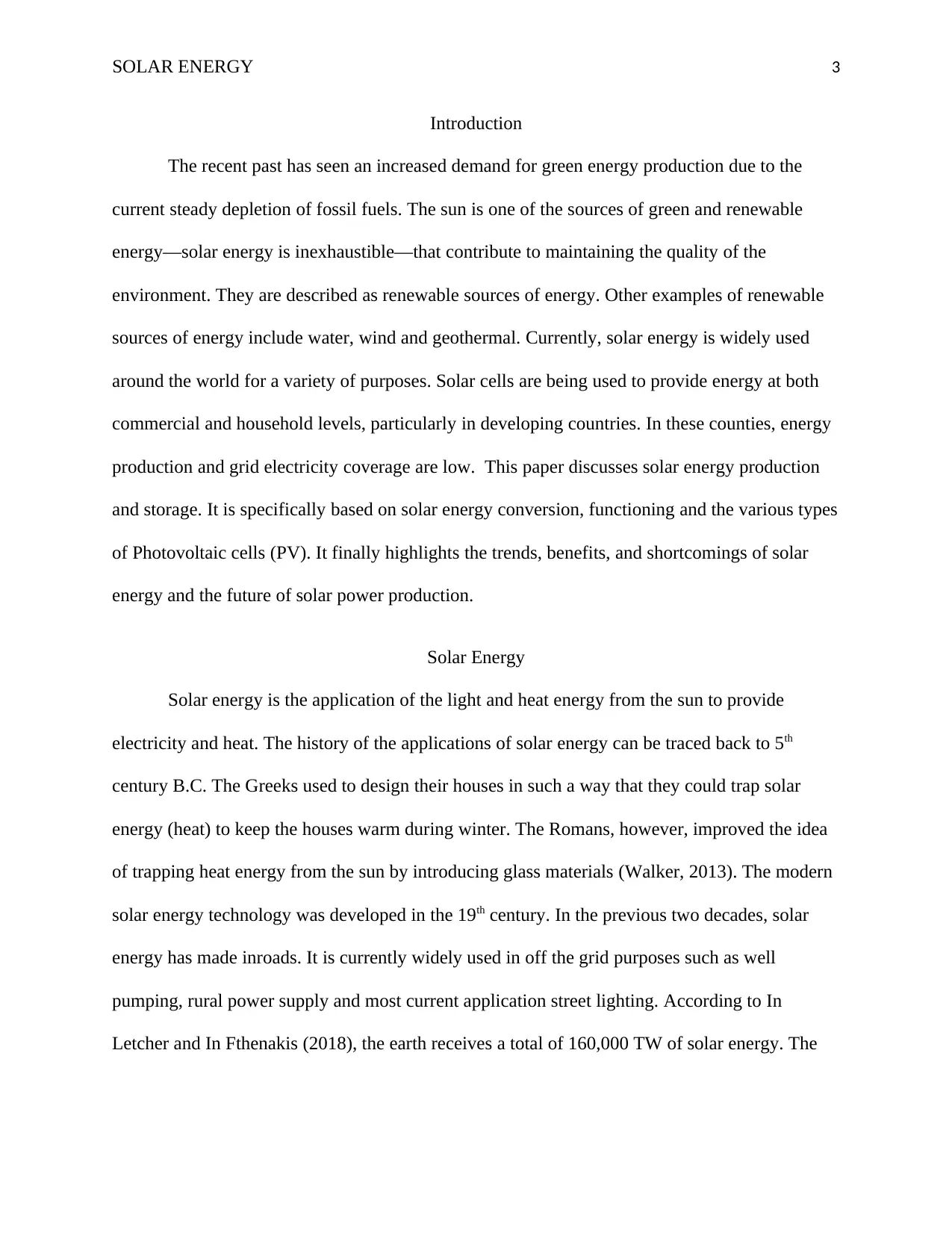
SOLAR ENERGY 3
Introduction
The recent past has seen an increased demand for green energy production due to the
current steady depletion of fossil fuels. The sun is one of the sources of green and renewable
energy—solar energy is inexhaustible—that contribute to maintaining the quality of the
environment. They are described as renewable sources of energy. Other examples of renewable
sources of energy include water, wind and geothermal. Currently, solar energy is widely used
around the world for a variety of purposes. Solar cells are being used to provide energy at both
commercial and household levels, particularly in developing countries. In these counties, energy
production and grid electricity coverage are low. This paper discusses solar energy production
and storage. It is specifically based on solar energy conversion, functioning and the various types
of Photovoltaic cells (PV). It finally highlights the trends, benefits, and shortcomings of solar
energy and the future of solar power production.
Solar Energy
Solar energy is the application of the light and heat energy from the sun to provide
electricity and heat. The history of the applications of solar energy can be traced back to 5th
century B.C. The Greeks used to design their houses in such a way that they could trap solar
energy (heat) to keep the houses warm during winter. The Romans, however, improved the idea
of trapping heat energy from the sun by introducing glass materials (Walker, 2013). The modern
solar energy technology was developed in the 19th century. In the previous two decades, solar
energy has made inroads. It is currently widely used in off the grid purposes such as well
pumping, rural power supply and most current application street lighting. According to In
Letcher and In Fthenakis (2018), the earth receives a total of 160,000 TW of solar energy. The
Introduction
The recent past has seen an increased demand for green energy production due to the
current steady depletion of fossil fuels. The sun is one of the sources of green and renewable
energy—solar energy is inexhaustible—that contribute to maintaining the quality of the
environment. They are described as renewable sources of energy. Other examples of renewable
sources of energy include water, wind and geothermal. Currently, solar energy is widely used
around the world for a variety of purposes. Solar cells are being used to provide energy at both
commercial and household levels, particularly in developing countries. In these counties, energy
production and grid electricity coverage are low. This paper discusses solar energy production
and storage. It is specifically based on solar energy conversion, functioning and the various types
of Photovoltaic cells (PV). It finally highlights the trends, benefits, and shortcomings of solar
energy and the future of solar power production.
Solar Energy
Solar energy is the application of the light and heat energy from the sun to provide
electricity and heat. The history of the applications of solar energy can be traced back to 5th
century B.C. The Greeks used to design their houses in such a way that they could trap solar
energy (heat) to keep the houses warm during winter. The Romans, however, improved the idea
of trapping heat energy from the sun by introducing glass materials (Walker, 2013). The modern
solar energy technology was developed in the 19th century. In the previous two decades, solar
energy has made inroads. It is currently widely used in off the grid purposes such as well
pumping, rural power supply and most current application street lighting. According to In
Letcher and In Fthenakis (2018), the earth receives a total of 160,000 TW of solar energy. The
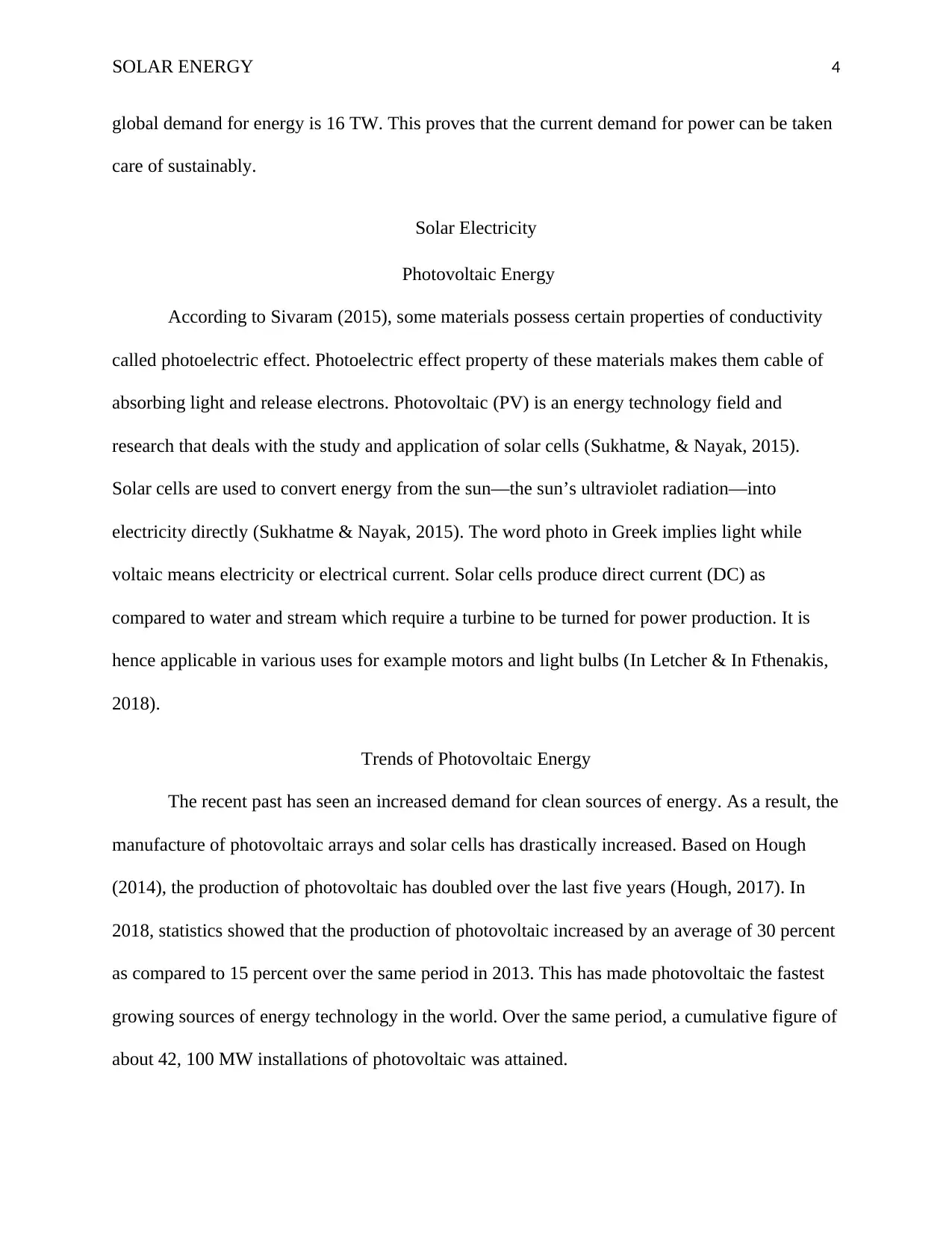
SOLAR ENERGY 4
global demand for energy is 16 TW. This proves that the current demand for power can be taken
care of sustainably.
Solar Electricity
Photovoltaic Energy
According to Sivaram (2015), some materials possess certain properties of conductivity
called photoelectric effect. Photoelectric effect property of these materials makes them cable of
absorbing light and release electrons. Photovoltaic (PV) is an energy technology field and
research that deals with the study and application of solar cells (Sukhatme, & Nayak, 2015).
Solar cells are used to convert energy from the sun—the sun’s ultraviolet radiation—into
electricity directly (Sukhatme & Nayak, 2015). The word photo in Greek implies light while
voltaic means electricity or electrical current. Solar cells produce direct current (DC) as
compared to water and stream which require a turbine to be turned for power production. It is
hence applicable in various uses for example motors and light bulbs (In Letcher & In Fthenakis,
2018).
Trends of Photovoltaic Energy
The recent past has seen an increased demand for clean sources of energy. As a result, the
manufacture of photovoltaic arrays and solar cells has drastically increased. Based on Hough
(2014), the production of photovoltaic has doubled over the last five years (Hough, 2017). In
2018, statistics showed that the production of photovoltaic increased by an average of 30 percent
as compared to 15 percent over the same period in 2013. This has made photovoltaic the fastest
growing sources of energy technology in the world. Over the same period, a cumulative figure of
about 42, 100 MW installations of photovoltaic was attained.
global demand for energy is 16 TW. This proves that the current demand for power can be taken
care of sustainably.
Solar Electricity
Photovoltaic Energy
According to Sivaram (2015), some materials possess certain properties of conductivity
called photoelectric effect. Photoelectric effect property of these materials makes them cable of
absorbing light and release electrons. Photovoltaic (PV) is an energy technology field and
research that deals with the study and application of solar cells (Sukhatme, & Nayak, 2015).
Solar cells are used to convert energy from the sun—the sun’s ultraviolet radiation—into
electricity directly (Sukhatme & Nayak, 2015). The word photo in Greek implies light while
voltaic means electricity or electrical current. Solar cells produce direct current (DC) as
compared to water and stream which require a turbine to be turned for power production. It is
hence applicable in various uses for example motors and light bulbs (In Letcher & In Fthenakis,
2018).
Trends of Photovoltaic Energy
The recent past has seen an increased demand for clean sources of energy. As a result, the
manufacture of photovoltaic arrays and solar cells has drastically increased. Based on Hough
(2014), the production of photovoltaic has doubled over the last five years (Hough, 2017). In
2018, statistics showed that the production of photovoltaic increased by an average of 30 percent
as compared to 15 percent over the same period in 2013. This has made photovoltaic the fastest
growing sources of energy technology in the world. Over the same period, a cumulative figure of
about 42, 100 MW installations of photovoltaic was attained.
Secure Best Marks with AI Grader
Need help grading? Try our AI Grader for instant feedback on your assignments.
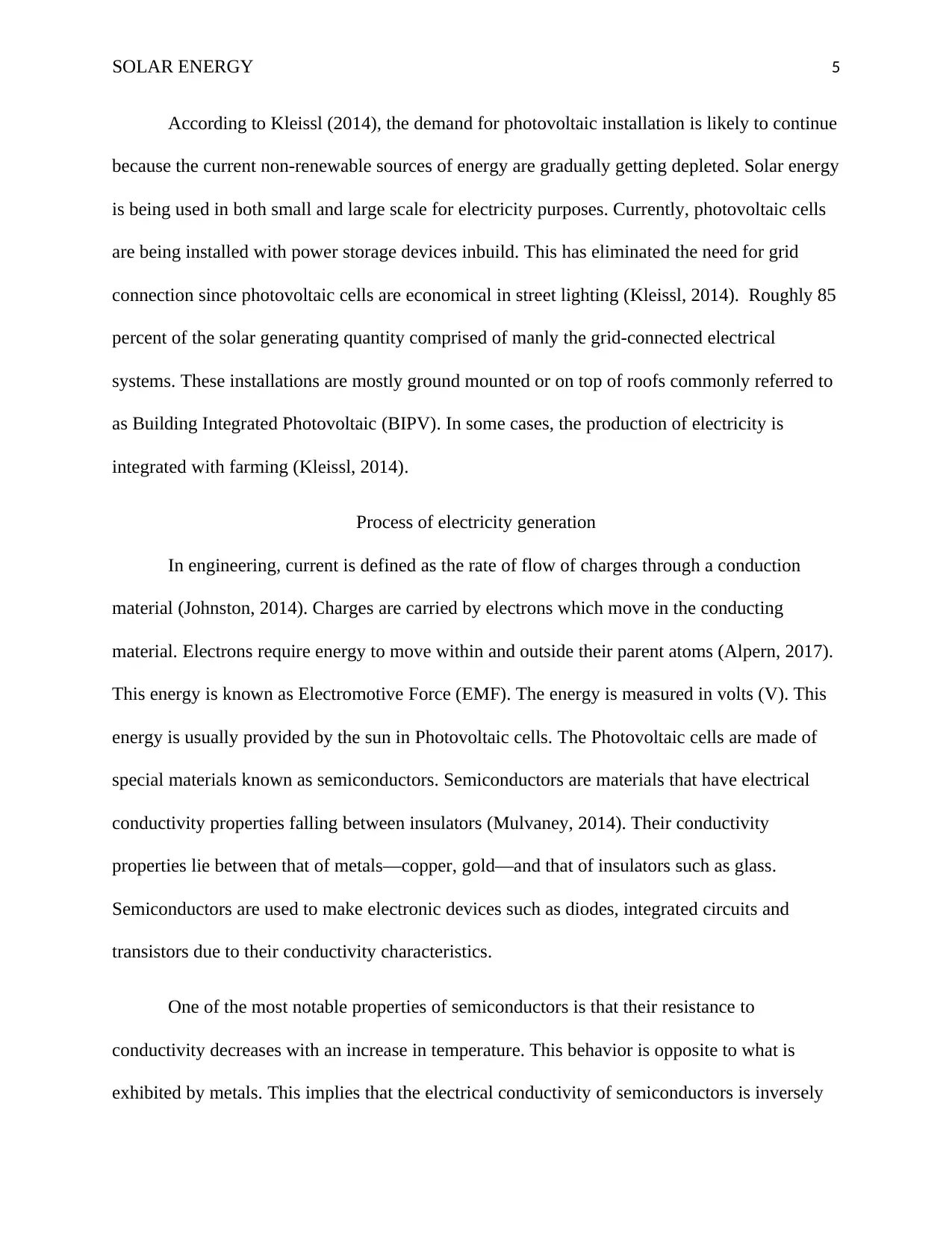
SOLAR ENERGY 5
According to Kleissl (2014), the demand for photovoltaic installation is likely to continue
because the current non-renewable sources of energy are gradually getting depleted. Solar energy
is being used in both small and large scale for electricity purposes. Currently, photovoltaic cells
are being installed with power storage devices inbuild. This has eliminated the need for grid
connection since photovoltaic cells are economical in street lighting (Kleissl, 2014). Roughly 85
percent of the solar generating quantity comprised of manly the grid-connected electrical
systems. These installations are mostly ground mounted or on top of roofs commonly referred to
as Building Integrated Photovoltaic (BIPV). In some cases, the production of electricity is
integrated with farming (Kleissl, 2014).
Process of electricity generation
In engineering, current is defined as the rate of flow of charges through a conduction
material (Johnston, 2014). Charges are carried by electrons which move in the conducting
material. Electrons require energy to move within and outside their parent atoms (Alpern, 2017).
This energy is known as Electromotive Force (EMF). The energy is measured in volts (V). This
energy is usually provided by the sun in Photovoltaic cells. The Photovoltaic cells are made of
special materials known as semiconductors. Semiconductors are materials that have electrical
conductivity properties falling between insulators (Mulvaney, 2014). Their conductivity
properties lie between that of metals—copper, gold—and that of insulators such as glass.
Semiconductors are used to make electronic devices such as diodes, integrated circuits and
transistors due to their conductivity characteristics.
One of the most notable properties of semiconductors is that their resistance to
conductivity decreases with an increase in temperature. This behavior is opposite to what is
exhibited by metals. This implies that the electrical conductivity of semiconductors is inversely
According to Kleissl (2014), the demand for photovoltaic installation is likely to continue
because the current non-renewable sources of energy are gradually getting depleted. Solar energy
is being used in both small and large scale for electricity purposes. Currently, photovoltaic cells
are being installed with power storage devices inbuild. This has eliminated the need for grid
connection since photovoltaic cells are economical in street lighting (Kleissl, 2014). Roughly 85
percent of the solar generating quantity comprised of manly the grid-connected electrical
systems. These installations are mostly ground mounted or on top of roofs commonly referred to
as Building Integrated Photovoltaic (BIPV). In some cases, the production of electricity is
integrated with farming (Kleissl, 2014).
Process of electricity generation
In engineering, current is defined as the rate of flow of charges through a conduction
material (Johnston, 2014). Charges are carried by electrons which move in the conducting
material. Electrons require energy to move within and outside their parent atoms (Alpern, 2017).
This energy is known as Electromotive Force (EMF). The energy is measured in volts (V). This
energy is usually provided by the sun in Photovoltaic cells. The Photovoltaic cells are made of
special materials known as semiconductors. Semiconductors are materials that have electrical
conductivity properties falling between insulators (Mulvaney, 2014). Their conductivity
properties lie between that of metals—copper, gold—and that of insulators such as glass.
Semiconductors are used to make electronic devices such as diodes, integrated circuits and
transistors due to their conductivity characteristics.
One of the most notable properties of semiconductors is that their resistance to
conductivity decreases with an increase in temperature. This behavior is opposite to what is
exhibited by metals. This implies that the electrical conductivity of semiconductors is inversely

SOLAR ENERGY 6
proposal to temperature (Alpern, 2017). Solar cells are made of silicon; a semiconductor that is
used to convert a photo of light to electrical power. Light energy from the sun gets absorbed
when it falls on the silicon semiconductor (Kalogirou, 2013). The energy has to be enough to
knock electrons loose from the attractive forces holding them in the silicon atoms (Brownson,
2014). From the above, the flow of charges is known as current. Solar cells have an electric field
that forces electrons to flow in a particular direction. Since flowing electrons carry charges, the
free electrons form current.
Figure 1. About Solar Energy - Solar Power Working (Johnston, 2014).
Retrieved from http://www.solarworksforamerica.org/about-solar-energy/
The metal conductors placed at the bottom of the Photovoltaic cells draw the current off
for storage or use. Power is the rate of doing work (Sukhatme & Nayak, 2015). The current
together with the voltage of the cell yields power that can be produced by the solar cell. There
are three layers that facilitate solar energy conversion in a solar cell. The foremost layer—
located at the top—is known as the junction layer (Sukhatme & Nayak, 2015). It is made of N-
type of semiconductors. N-type of semiconductors are made adding a small amount of
proposal to temperature (Alpern, 2017). Solar cells are made of silicon; a semiconductor that is
used to convert a photo of light to electrical power. Light energy from the sun gets absorbed
when it falls on the silicon semiconductor (Kalogirou, 2013). The energy has to be enough to
knock electrons loose from the attractive forces holding them in the silicon atoms (Brownson,
2014). From the above, the flow of charges is known as current. Solar cells have an electric field
that forces electrons to flow in a particular direction. Since flowing electrons carry charges, the
free electrons form current.
Figure 1. About Solar Energy - Solar Power Working (Johnston, 2014).
Retrieved from http://www.solarworksforamerica.org/about-solar-energy/
The metal conductors placed at the bottom of the Photovoltaic cells draw the current off
for storage or use. Power is the rate of doing work (Sukhatme & Nayak, 2015). The current
together with the voltage of the cell yields power that can be produced by the solar cell. There
are three layers that facilitate solar energy conversion in a solar cell. The foremost layer—
located at the top—is known as the junction layer (Sukhatme & Nayak, 2015). It is made of N-
type of semiconductors. N-type of semiconductors are made adding a small amount of

SOLAR ENERGY 7
pentavalent impurity is added to a pure semiconductor. This essentially adds extra electrons to
the pure semiconductor. The improved conduction in n-type semiconductors is due to the
electrons that are donated by the impurity (Alpern, 2017). The impurity is known as a donor
since it adds elections to the semiconductor; each atom of the impurity adds/ donates a free
crystal of electron. An excellent example of this type of impurities include arsenic Mulvaney,
2014).
The second layer is the absorber layer which is at the core of the device. It is made of P-N
junction. A p-n junction forms a boundary between two semiconductors that have different
electron affinities (Walker, 2013). A p-n junction is like a terminal. It is created by doping a
semiconductor with two different types of impurities; p-type and n-type materials. The junction
acts as a transport media for elections between the two types of impurities (Brownson, 2014).
Electrons in the n-type side and free holes on the p-type side move across the junction. The holes
are positively charged in nature because they have electron deficiency (Sukhatme & Nayak,
2015). As the electrons in the n-type and the holes in the p-type semiconductors cancel out, a
region of depleted charge is created. This region is referred to as the depletion zone.
The lower layer (back) compromises of p-type semiconductor. Scientifically, P-type
semiconductors mainly use holes as mentioned above to carry charges (Brownson, 2014).
Electrons in these semiconductors are the least charge carriers. These semiconductors are made
by doping an intrinsic semiconductor with acceptor—opposite of donor—impurities (Alpern,
2017). The most common intrinsic semiconductor impurity for Silicon is Boron. This layer is
used primarily to maintain an opposite charge in the solar cell (In Lovegrove & In Stein, 2016).
The opposite charge maintains flow one direction flow of electrons in the solar cell. There are
two additional layers in the PV cell; two electrical conducting layers (Sukhatme, 2015). The
pentavalent impurity is added to a pure semiconductor. This essentially adds extra electrons to
the pure semiconductor. The improved conduction in n-type semiconductors is due to the
electrons that are donated by the impurity (Alpern, 2017). The impurity is known as a donor
since it adds elections to the semiconductor; each atom of the impurity adds/ donates a free
crystal of electron. An excellent example of this type of impurities include arsenic Mulvaney,
2014).
The second layer is the absorber layer which is at the core of the device. It is made of P-N
junction. A p-n junction forms a boundary between two semiconductors that have different
electron affinities (Walker, 2013). A p-n junction is like a terminal. It is created by doping a
semiconductor with two different types of impurities; p-type and n-type materials. The junction
acts as a transport media for elections between the two types of impurities (Brownson, 2014).
Electrons in the n-type side and free holes on the p-type side move across the junction. The holes
are positively charged in nature because they have electron deficiency (Sukhatme & Nayak,
2015). As the electrons in the n-type and the holes in the p-type semiconductors cancel out, a
region of depleted charge is created. This region is referred to as the depletion zone.
The lower layer (back) compromises of p-type semiconductor. Scientifically, P-type
semiconductors mainly use holes as mentioned above to carry charges (Brownson, 2014).
Electrons in these semiconductors are the least charge carriers. These semiconductors are made
by doping an intrinsic semiconductor with acceptor—opposite of donor—impurities (Alpern,
2017). The most common intrinsic semiconductor impurity for Silicon is Boron. This layer is
used primarily to maintain an opposite charge in the solar cell (In Lovegrove & In Stein, 2016).
The opposite charge maintains flow one direction flow of electrons in the solar cell. There are
two additional layers in the PV cell; two electrical conducting layers (Sukhatme, 2015). The
Paraphrase This Document
Need a fresh take? Get an instant paraphrase of this document with our AI Paraphraser
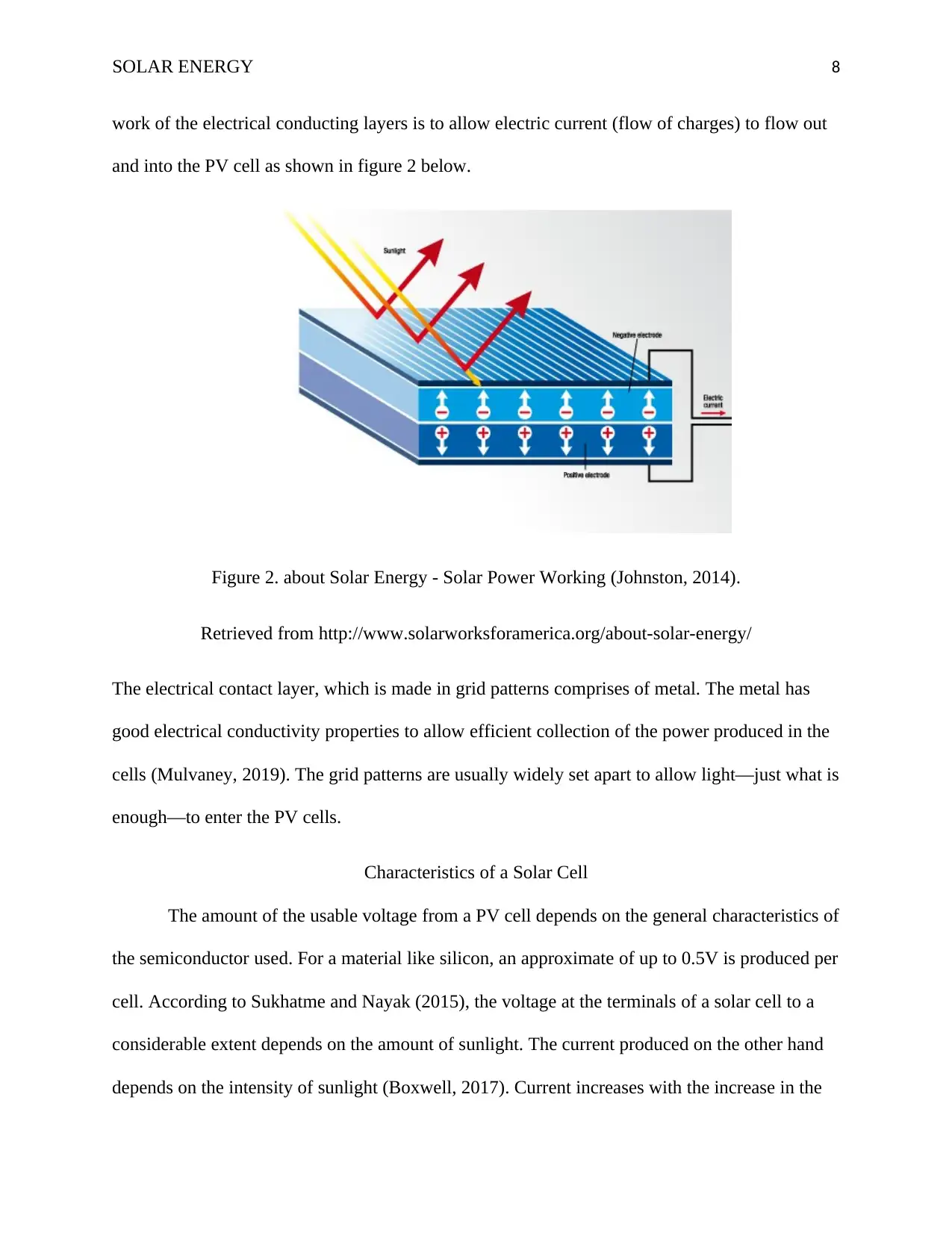
SOLAR ENERGY 8
work of the electrical conducting layers is to allow electric current (flow of charges) to flow out
and into the PV cell as shown in figure 2 below.
Figure 2. about Solar Energy - Solar Power Working (Johnston, 2014).
Retrieved from http://www.solarworksforamerica.org/about-solar-energy/
The electrical contact layer, which is made in grid patterns comprises of metal. The metal has
good electrical conductivity properties to allow efficient collection of the power produced in the
cells (Mulvaney, 2019). The grid patterns are usually widely set apart to allow light—just what is
enough—to enter the PV cells.
Characteristics of a Solar Cell
The amount of the usable voltage from a PV cell depends on the general characteristics of
the semiconductor used. For a material like silicon, an approximate of up to 0.5V is produced per
cell. According to Sukhatme and Nayak (2015), the voltage at the terminals of a solar cell to a
considerable extent depends on the amount of sunlight. The current produced on the other hand
depends on the intensity of sunlight (Boxwell, 2017). Current increases with the increase in the
work of the electrical conducting layers is to allow electric current (flow of charges) to flow out
and into the PV cell as shown in figure 2 below.
Figure 2. about Solar Energy - Solar Power Working (Johnston, 2014).
Retrieved from http://www.solarworksforamerica.org/about-solar-energy/
The electrical contact layer, which is made in grid patterns comprises of metal. The metal has
good electrical conductivity properties to allow efficient collection of the power produced in the
cells (Mulvaney, 2019). The grid patterns are usually widely set apart to allow light—just what is
enough—to enter the PV cells.
Characteristics of a Solar Cell
The amount of the usable voltage from a PV cell depends on the general characteristics of
the semiconductor used. For a material like silicon, an approximate of up to 0.5V is produced per
cell. According to Sukhatme and Nayak (2015), the voltage at the terminals of a solar cell to a
considerable extent depends on the amount of sunlight. The current produced on the other hand
depends on the intensity of sunlight (Boxwell, 2017). Current increases with the increase in the
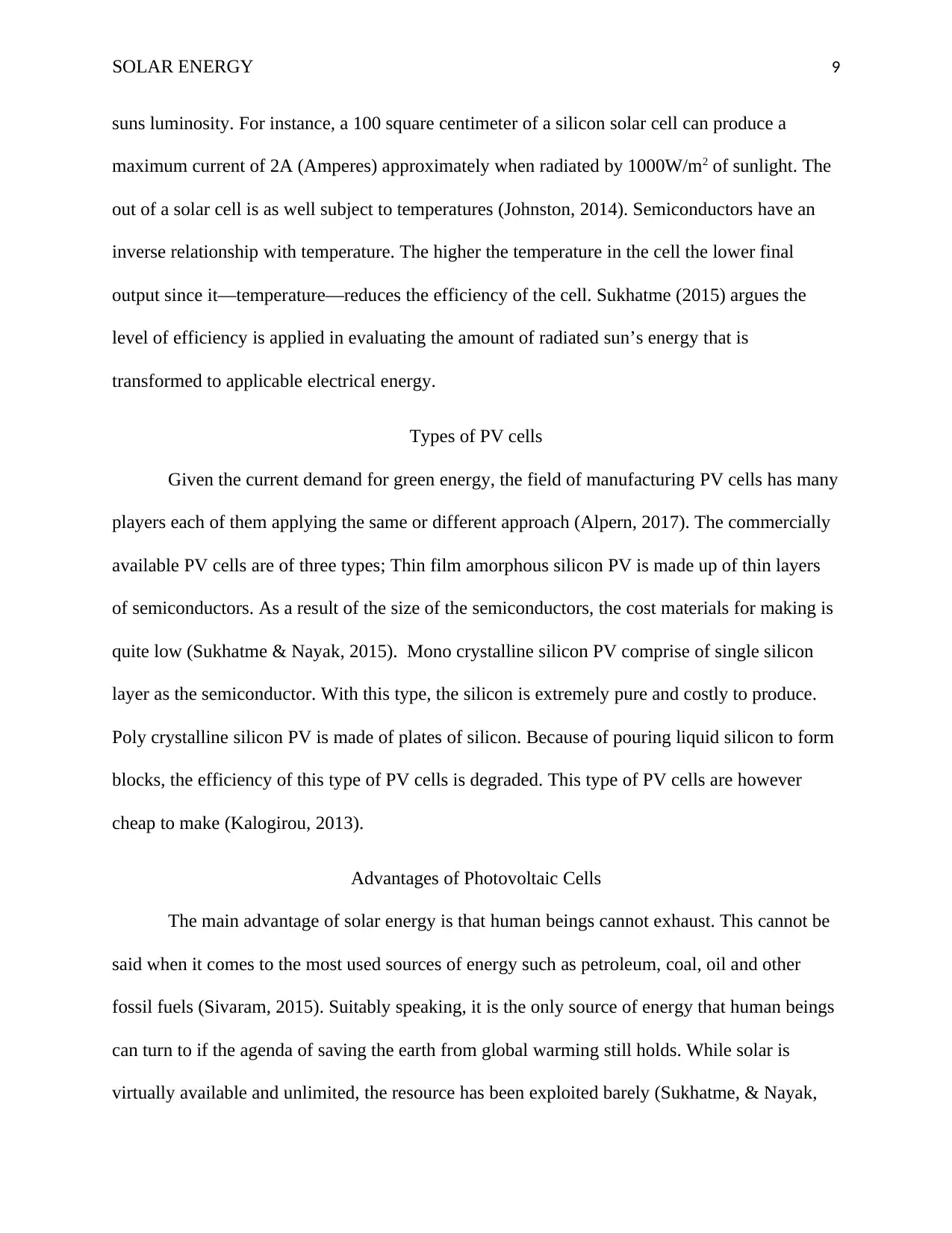
SOLAR ENERGY 9
suns luminosity. For instance, a 100 square centimeter of a silicon solar cell can produce a
maximum current of 2A (Amperes) approximately when radiated by 1000W/m2 of sunlight. The
out of a solar cell is as well subject to temperatures (Johnston, 2014). Semiconductors have an
inverse relationship with temperature. The higher the temperature in the cell the lower final
output since it—temperature—reduces the efficiency of the cell. Sukhatme (2015) argues the
level of efficiency is applied in evaluating the amount of radiated sun’s energy that is
transformed to applicable electrical energy.
Types of PV cells
Given the current demand for green energy, the field of manufacturing PV cells has many
players each of them applying the same or different approach (Alpern, 2017). The commercially
available PV cells are of three types; Thin film amorphous silicon PV is made up of thin layers
of semiconductors. As a result of the size of the semiconductors, the cost materials for making is
quite low (Sukhatme & Nayak, 2015). Mono crystalline silicon PV comprise of single silicon
layer as the semiconductor. With this type, the silicon is extremely pure and costly to produce.
Poly crystalline silicon PV is made of plates of silicon. Because of pouring liquid silicon to form
blocks, the efficiency of this type of PV cells is degraded. This type of PV cells are however
cheap to make (Kalogirou, 2013).
Advantages of Photovoltaic Cells
The main advantage of solar energy is that human beings cannot exhaust. This cannot be
said when it comes to the most used sources of energy such as petroleum, coal, oil and other
fossil fuels (Sivaram, 2015). Suitably speaking, it is the only source of energy that human beings
can turn to if the agenda of saving the earth from global warming still holds. While solar is
virtually available and unlimited, the resource has been exploited barely (Sukhatme, & Nayak,
suns luminosity. For instance, a 100 square centimeter of a silicon solar cell can produce a
maximum current of 2A (Amperes) approximately when radiated by 1000W/m2 of sunlight. The
out of a solar cell is as well subject to temperatures (Johnston, 2014). Semiconductors have an
inverse relationship with temperature. The higher the temperature in the cell the lower final
output since it—temperature—reduces the efficiency of the cell. Sukhatme (2015) argues the
level of efficiency is applied in evaluating the amount of radiated sun’s energy that is
transformed to applicable electrical energy.
Types of PV cells
Given the current demand for green energy, the field of manufacturing PV cells has many
players each of them applying the same or different approach (Alpern, 2017). The commercially
available PV cells are of three types; Thin film amorphous silicon PV is made up of thin layers
of semiconductors. As a result of the size of the semiconductors, the cost materials for making is
quite low (Sukhatme & Nayak, 2015). Mono crystalline silicon PV comprise of single silicon
layer as the semiconductor. With this type, the silicon is extremely pure and costly to produce.
Poly crystalline silicon PV is made of plates of silicon. Because of pouring liquid silicon to form
blocks, the efficiency of this type of PV cells is degraded. This type of PV cells are however
cheap to make (Kalogirou, 2013).
Advantages of Photovoltaic Cells
The main advantage of solar energy is that human beings cannot exhaust. This cannot be
said when it comes to the most used sources of energy such as petroleum, coal, oil and other
fossil fuels (Sivaram, 2015). Suitably speaking, it is the only source of energy that human beings
can turn to if the agenda of saving the earth from global warming still holds. While solar is
virtually available and unlimited, the resource has been exploited barely (Sukhatme, & Nayak,
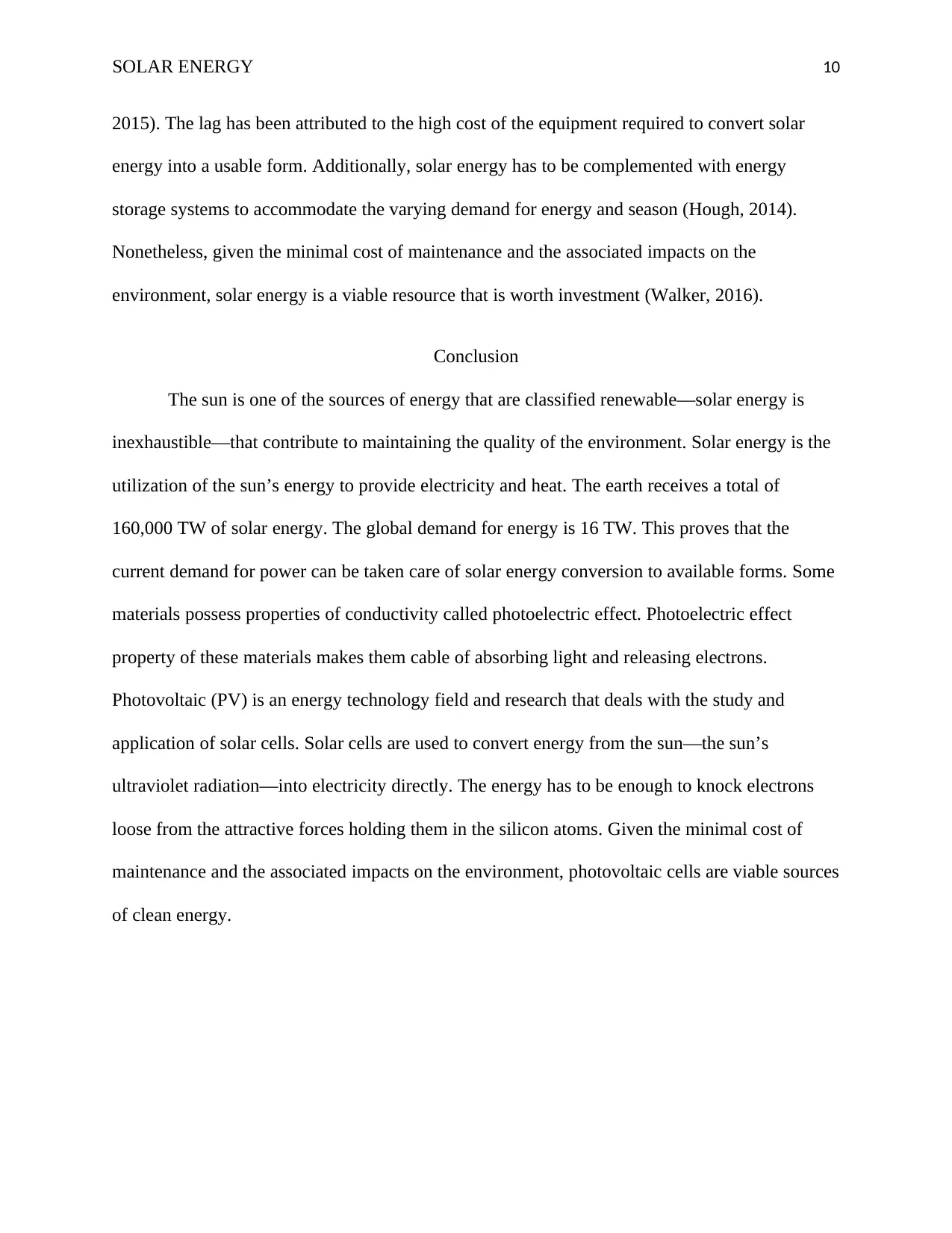
SOLAR ENERGY 10
2015). The lag has been attributed to the high cost of the equipment required to convert solar
energy into a usable form. Additionally, solar energy has to be complemented with energy
storage systems to accommodate the varying demand for energy and season (Hough, 2014).
Nonetheless, given the minimal cost of maintenance and the associated impacts on the
environment, solar energy is a viable resource that is worth investment (Walker, 2016).
Conclusion
The sun is one of the sources of energy that are classified renewable—solar energy is
inexhaustible—that contribute to maintaining the quality of the environment. Solar energy is the
utilization of the sun’s energy to provide electricity and heat. The earth receives a total of
160,000 TW of solar energy. The global demand for energy is 16 TW. This proves that the
current demand for power can be taken care of solar energy conversion to available forms. Some
materials possess properties of conductivity called photoelectric effect. Photoelectric effect
property of these materials makes them cable of absorbing light and releasing electrons.
Photovoltaic (PV) is an energy technology field and research that deals with the study and
application of solar cells. Solar cells are used to convert energy from the sun—the sun’s
ultraviolet radiation—into electricity directly. The energy has to be enough to knock electrons
loose from the attractive forces holding them in the silicon atoms. Given the minimal cost of
maintenance and the associated impacts on the environment, photovoltaic cells are viable sources
of clean energy.
2015). The lag has been attributed to the high cost of the equipment required to convert solar
energy into a usable form. Additionally, solar energy has to be complemented with energy
storage systems to accommodate the varying demand for energy and season (Hough, 2014).
Nonetheless, given the minimal cost of maintenance and the associated impacts on the
environment, solar energy is a viable resource that is worth investment (Walker, 2016).
Conclusion
The sun is one of the sources of energy that are classified renewable—solar energy is
inexhaustible—that contribute to maintaining the quality of the environment. Solar energy is the
utilization of the sun’s energy to provide electricity and heat. The earth receives a total of
160,000 TW of solar energy. The global demand for energy is 16 TW. This proves that the
current demand for power can be taken care of solar energy conversion to available forms. Some
materials possess properties of conductivity called photoelectric effect. Photoelectric effect
property of these materials makes them cable of absorbing light and releasing electrons.
Photovoltaic (PV) is an energy technology field and research that deals with the study and
application of solar cells. Solar cells are used to convert energy from the sun—the sun’s
ultraviolet radiation—into electricity directly. The energy has to be enough to knock electrons
loose from the attractive forces holding them in the silicon atoms. Given the minimal cost of
maintenance and the associated impacts on the environment, photovoltaic cells are viable sources
of clean energy.
Secure Best Marks with AI Grader
Need help grading? Try our AI Grader for instant feedback on your assignments.
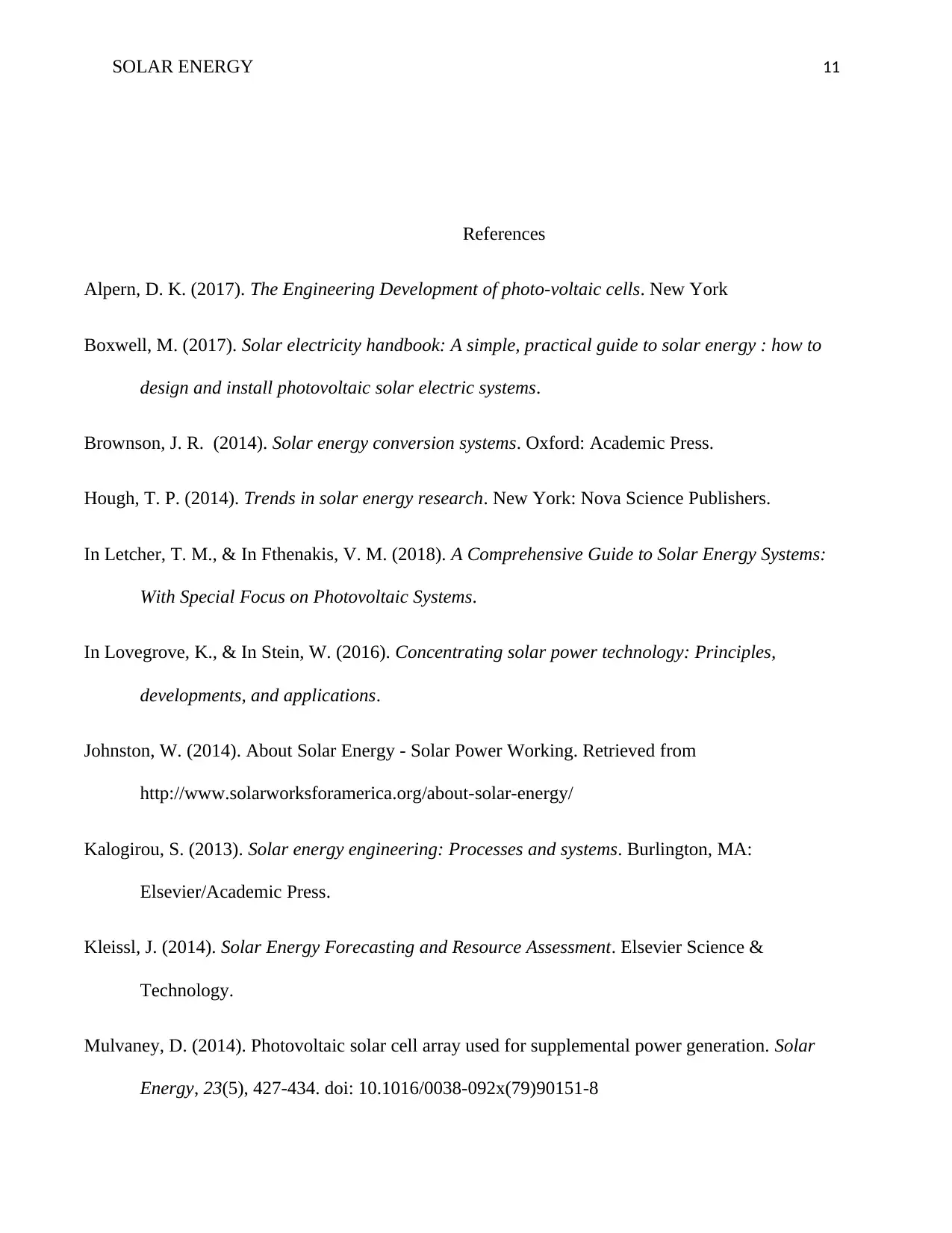
SOLAR ENERGY 11
References
Alpern, D. K. (2017). The Engineering Development of photo-voltaic cells. New York
Boxwell, M. (2017). Solar electricity handbook: A simple, practical guide to solar energy : how to
design and install photovoltaic solar electric systems.
Brownson, J. R. (2014). Solar energy conversion systems. Oxford: Academic Press.
Hough, T. P. (2014). Trends in solar energy research. New York: Nova Science Publishers.
In Letcher, T. M., & In Fthenakis, V. M. (2018). A Comprehensive Guide to Solar Energy Systems:
With Special Focus on Photovoltaic Systems.
In Lovegrove, K., & In Stein, W. (2016). Concentrating solar power technology: Principles,
developments, and applications.
Johnston, W. (2014). About Solar Energy - Solar Power Working. Retrieved from
http://www.solarworksforamerica.org/about-solar-energy/
Kalogirou, S. (2013). Solar energy engineering: Processes and systems. Burlington, MA:
Elsevier/Academic Press.
Kleissl, J. (2014). Solar Energy Forecasting and Resource Assessment. Elsevier Science &
Technology.
Mulvaney, D. (2014). Photovoltaic solar cell array used for supplemental power generation. Solar
Energy, 23(5), 427-434. doi: 10.1016/0038-092x(79)90151-8
References
Alpern, D. K. (2017). The Engineering Development of photo-voltaic cells. New York
Boxwell, M. (2017). Solar electricity handbook: A simple, practical guide to solar energy : how to
design and install photovoltaic solar electric systems.
Brownson, J. R. (2014). Solar energy conversion systems. Oxford: Academic Press.
Hough, T. P. (2014). Trends in solar energy research. New York: Nova Science Publishers.
In Letcher, T. M., & In Fthenakis, V. M. (2018). A Comprehensive Guide to Solar Energy Systems:
With Special Focus on Photovoltaic Systems.
In Lovegrove, K., & In Stein, W. (2016). Concentrating solar power technology: Principles,
developments, and applications.
Johnston, W. (2014). About Solar Energy - Solar Power Working. Retrieved from
http://www.solarworksforamerica.org/about-solar-energy/
Kalogirou, S. (2013). Solar energy engineering: Processes and systems. Burlington, MA:
Elsevier/Academic Press.
Kleissl, J. (2014). Solar Energy Forecasting and Resource Assessment. Elsevier Science &
Technology.
Mulvaney, D. (2014). Photovoltaic solar cell array used for supplemental power generation. Solar
Energy, 23(5), 427-434. doi: 10.1016/0038-092x(79)90151-8

SOLAR ENERGY 12
Mulvaney, D. (2019). Solar power: Innovation, sustainability, and environmental justice. New
York: PowerKids Press.
Sivaram, V. (2015). Taming the sun: Innovations to harness solar energy and power the planet.
Sukhatme, S. P. (2015). Solar energy principles of thermal collection and storage. New Delhi: Tata
McGraw-Hill.
Sukhatme, S. P., & Nayak, J. K. (2015). Solar energy: Principles of thermal collection and storage.
New Delhi: Tata McGraw-Hill.
Walker, A. (2013). Solar energy: Technologies and the project delivery process for buildings.
Walker, T. P. (2016). Solar energy: New research. New York: Nova Science Publishers.
Mulvaney, D. (2019). Solar power: Innovation, sustainability, and environmental justice. New
York: PowerKids Press.
Sivaram, V. (2015). Taming the sun: Innovations to harness solar energy and power the planet.
Sukhatme, S. P. (2015). Solar energy principles of thermal collection and storage. New Delhi: Tata
McGraw-Hill.
Sukhatme, S. P., & Nayak, J. K. (2015). Solar energy: Principles of thermal collection and storage.
New Delhi: Tata McGraw-Hill.
Walker, A. (2013). Solar energy: Technologies and the project delivery process for buildings.
Walker, T. P. (2016). Solar energy: New research. New York: Nova Science Publishers.
1 out of 12
Related Documents
Your All-in-One AI-Powered Toolkit for Academic Success.
+13062052269
info@desklib.com
Available 24*7 on WhatsApp / Email
![[object Object]](/_next/static/media/star-bottom.7253800d.svg)
Unlock your academic potential
© 2024 | Zucol Services PVT LTD | All rights reserved.




